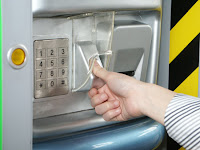In the last years has considerably increased the area of application of biometrics and it's expected that in the near future, we will use biometry many times in our dayly activities such as getting in the car, openning the door of our house, accessing to our bank acount, shoping by internet, accessing to our PDA, mobil phone, laptops, etc. Depending of where the biometrics is deployed, the applications can be categorized in the following five main groups: forensic, government, commercial, health-care and traveling and immigration. However, some applications are common to these groups such as physical access, PC/network access, time and attendance, etc.
- Identification of criminals- collecting the evidence in the scene of crime (e.g., fingerprints) it is possible to compare with data of suspects or make a search in the database of criminals.
- Surveillance- using cameras one can monitor the very busy places such as stadiums, airports, meetings, etc. Looking in the crowds for suspect, based on the face recognition biometric, using a images (e.g., mug shots) database of wanted persons or criminals.
- Probation and home arrest- biometric can also be used for post-release programs (conditional released) to ensure the fulfilment of the probation, parole and home detention terms.
Government
- National Identification Cards- the idea is to include digital biometric information in the national identification card. This is the most ambitious biometric program, since the identification must be performed in a large-scale database, containing hundred of millions samples, corresponding to the whole population of one country. This kind of cards can be used for multiple purposes such as controlling the collection of benefits, avoiding duplicates of voter registration and drivers license emission. All this applications are primarily based on finger-scan and AFIS technology, however it is possible that facial-scan and iris-scan technology could be used in the future.
- Voter ID and Elections- while the biometric national ID card is still in project, in many countries are already used the biometry for the control of voting and voter registration for the national or regional elections. During the registration of voter, the biometric data is captured and stored in the card and in the database for the later use during the voting. The purpose is to prevent the duplicate registration and voting.
- Driver's licenses- In many countries the driver license is also used as identification document, therefore it is important to prevent the duplicate emission of the driver license under different name. With the use of biometric this problem can be eliminated. however it is important that the data must be shared between state, because in some country such as United States, the license are controlled at the states as opposed to the federal level.
- Employee authentication- The government use of biometric for PC, network, and data access is also important for security of building and protection of information. Below are more detailed this kind of applications also used in commercial sector.
- Military programs- the military has long been interested in biometrics and the technology has enjoyed extensive support from the national security community.
Commercial
- Account access- The use of biometric for the access to the account in the bank allows to keep definitive and auditable records of account access by employees and customers. Using biometry the the customers can access accounts and employees can log into their workstations.
- ATMs- the use of biometric in the ATM transaction allows more security,
- Expanded Service Kiosks- A more receptive market for biometrics may be special purpose kiosks, using biometric verification to allow a greater variety of financial transaction than are currently available though standard ATMs.
- Online banking- Internet based account access is already widely used in many places, the inclusion of biometric will make more secure this type of transactions from home. Currently, there are many pilot programs using biometric in home banking.
- Telephony transaction- Voice-scan biometric can be used to make more secure the telephone-based transactions. In this type of application, when the costumer calls to make a transaction, a biometric system will authenticate the customer's identity based on his or her voice with no need of any additional device.
- PC/Network access- The use of biometric log-in to local PCs or remotely through network increase the security of the overall system keeping more protected the valuable information.
- Physical access- the biometric is widely used for controlling the access to building or restricted areas.
Travel and Immigration
- Air travel- In many airport are already used a biometric system in order to reduce the inspection processing time for authorized travelers.
- Border crossing- The use of biometrics to control the travelers crossing the national or state border is increasing, specially in regions with high volume of travelers or illegal immigrants.
- Employee access- Several airport use biometric to control the physical access of employees to secure areas.
- Passports- Some country already issues passports with biometric information on a barcode or smart chips. The use of biometrics prevent the emission of multiple passports for the same person and also facilitates the identification at the airports and border controls.



0 comments:
Post a Comment